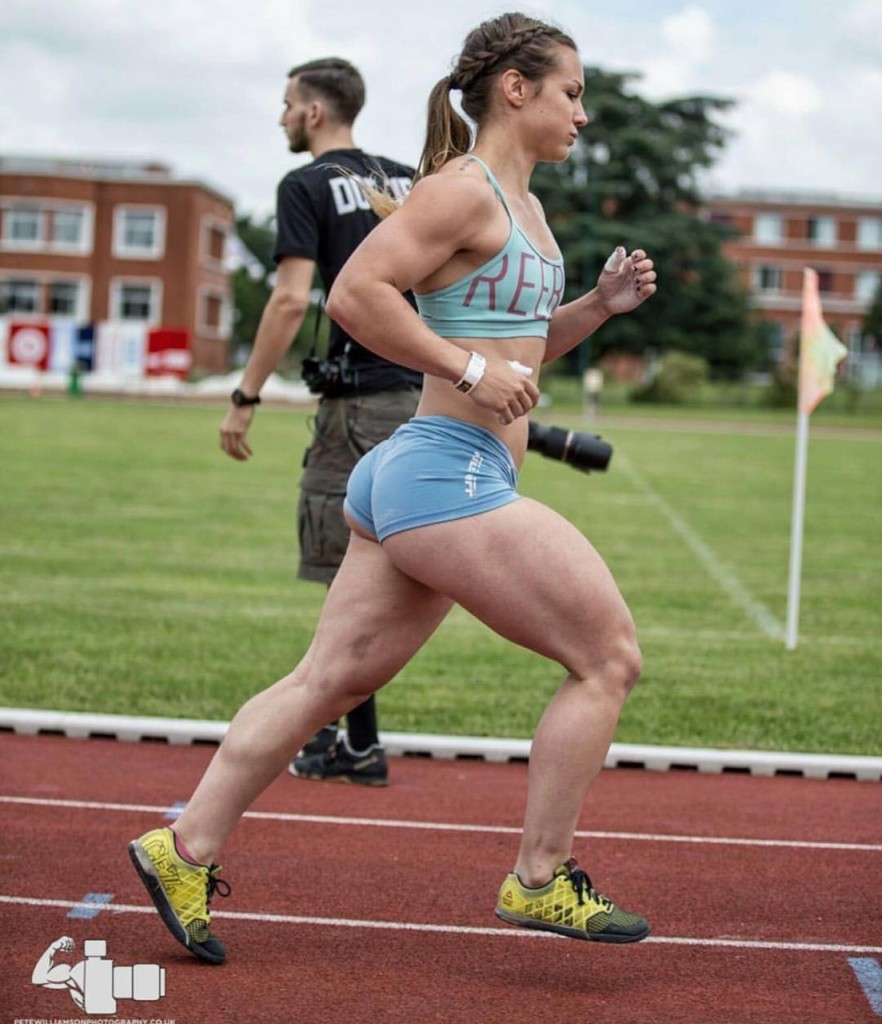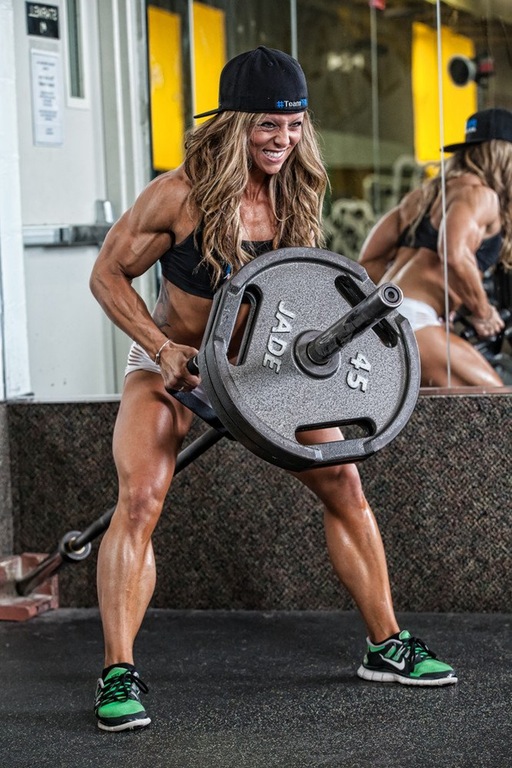 What can you achieve as a female lifter? There seem to be only 2 camps. The general public thinks a woman that touches a loaded barbell will wake up the next day as the SheHulk.
What can you achieve as a female lifter? There seem to be only 2 camps. The general public thinks a woman that touches a loaded barbell will wake up the next day as the SheHulk.
People with a bit more understanding of exercise physiology realize that this is obviously nonsense. One look around you in the average gym makes it clear that getting seriously big is difficult even for men. The statistic that women have ~15 times less testosterone than men is often quoted to explain that as a woman, you can’t grow much muscle anyway. So the common recommendation in today’s fitness circles is that women should train like men and should expect not to see much muscle growth.
The natural muscular potential of women
There is truth to this, but the causality runs in the opposite direction. Before I explain this, let’s first look at how the natural muscular potential of women compares to that of men. Percentage wise, how much muscle can a woman build compared to a man? Does it scale with testosterone so that women can build only ~7% as much muscle as men? Is it about half?
It’s 100%. Women gain the same percentage of muscle mass as men during strength training. In fact, women gain as much size and sometimes more strength than men . The only difference is the starting point. Men start off with more muscle mass and more strength, but the relative increase in muscle size is the same between men and women.
Research on protein metabolism comes to the same conclusion. Women build just as much muscle protein after training and after meals as men. In fact, one study found that given the same level of muscle mass, women have a higher rate of muscle protein synthesis than men.

Women vs. men in elite sports
If you think this is all just silly theory from labcoats studying beginners, consider this. Elite, natural female athletes have 85% as much muscle as elite male athletes. The studied sports included Olympic weightlifting and powerlifting. The 15% difference can easily be explained by 3 factors.
- Women have a genetically higher body fat percentage. Women have ~12% essential body fat to regulate their hormones compared to just ~3% fat in men. And you know, boobs.
- People have lower expectations of women, even most women themselves underestimate what they can achieve physically compared to men. In a famous study,simply telling people they were on steroids increased their strength gains by 321%. These were advanced trainees already benching and squatting over 300 pounds (137 kg) before taking the fake steroids. Moreover, the androgenic-anabolic steroid protocol in question was just 70 mg of Dianabol per week. Giving that same dosage of actual Dianabol to advanced trainees improves strength by only a few percent. So what do you think it does to women when you tell them they have 15 times less testosterone?
- There are more men in sports, so at the elite level, the selection to get to the top level is stronger. Elite male athletes are likely the best the male race has to offer. For women there may be more potential world record holders that will never know it because they don’t try.

What about testosterone?
Within an individual, more testosterone means more muscle mass. There is little doubt about that. Between genders, however, the relation becomes much weaker. In their study of elite athletes, Healy et al. concluded that “The difference in lean body mass is sufficient to account for the observed differences in strength and aerobic performance seen between the sexes without the need to hypothesize that performance is in any way determined by the differences in testosterone levels.”
How can this be? Testosterone functions differently in men and women, as I explained in my BioSignature review. In animals we have a good understanding of why testosterone is not needed for muscle development in women. It seems growth factors like IGF-1 and growth hormone take over the anabolic role that testosterone has in men. Growth factors are more important for strength and muscle mass in women than in men. Since women have just as much IGF-1 as men and women produce ~3 times as much growth hormone as men, this explains in part why having less testosterone does not limit how much muscle they can build. To make matters more complex, the sex hormones and growth factors interact and all these hormones also interact with your genes.
In short, saying women have less potential to build muscle mass because they don’t have as much testosterone as men is shortsighted.

The other sex hormone
Not only is testosterone not the great savior, estrogen is not the bad guy. Most people, even women, shun estrogen as the evil hormone that makes you bloated and does all sorts of negative things. Although it’s rarely described what exactly the negative effects of estrogen are, most people agree nonetheless that’s it’s bad for your body composition. This is complete nonsense. In my article on hormones and fat loss I explained the positive effects estrogen has on abdominal fat storage, but estrogen does many more awesome things.
- Estrogen aids in muscle repair.
- Estrogen is anti-catabolic and prevents muscle loss.
- Estrogen protects your joints, bones and tendons from injury.
- Estrogen does not make you fat. On the contrary, estrogen increases your metabolism.
These aren’t a few obscure and irrelevant findings I’m dragging up to support my point.Hundreds of studies have demonstrated the anabolic effects of estrogen. Estrogen is also crucial for your health, but that’s another topic. In short, estrogen’s bad reputation is based on nothing more than the poor intuition that if testosterone is anabolic, estrogen must be catabolic.
Why women shouldn’t train like men
Since women produce much more estrogen than men, this gives them several advantages over men in the gym. Women don’t fatigue as much as men and women recover faster after training. See this article a full review of why and how women should not train like men. There are many more important gender differences in metabolism, anatomy, neurology and physiology that I go into in my Bayesian PT Course and my seminar with client-turned-friend IFBB Pro Nina Ross. The important message here – to keep this article under a billion words – is that women and men are not the same and therefore they should not train or diet the same way. (If I just offended any feminists, get real.)
Why women aren’t living up to their potential
Women have the same relative natural muscular potential as men. They even have several advantages over men. So why don’t we see more muscular women? Several reasons have already come up in this article.
- Women are underrepresented in sports and in the gym. Even at the Olympic level there are fewer female participants. It is even true in science. There are over 50% fewer female participants in scientific studies than men.
- Even if women go to the gym, most of them spend their time on the treadmill or playing with pink dumbbells.
- We don’t have the same expectations of women. If a man benches a lot, that’s taken as a sign of social dominance. If a woman benches a lot, she’s seen as a freak, people get worried and men feel their pride sting and shrivel. I’ve heard from many of the women I train they’re approached in the gym ‘not too lift that heavy’ when they bench more than a plate.
- The women that do actually train seriously in spite of the stigma often train like men, which doesn’t align with their physiological strengths.
Conclusion
It’s time we stop treating women like second rate men. Women have just as much relative potential for muscle growth as men. It’s up to them if they want to fulfill that potential. If they do, they should realize they’re not men and train to their strengths.


